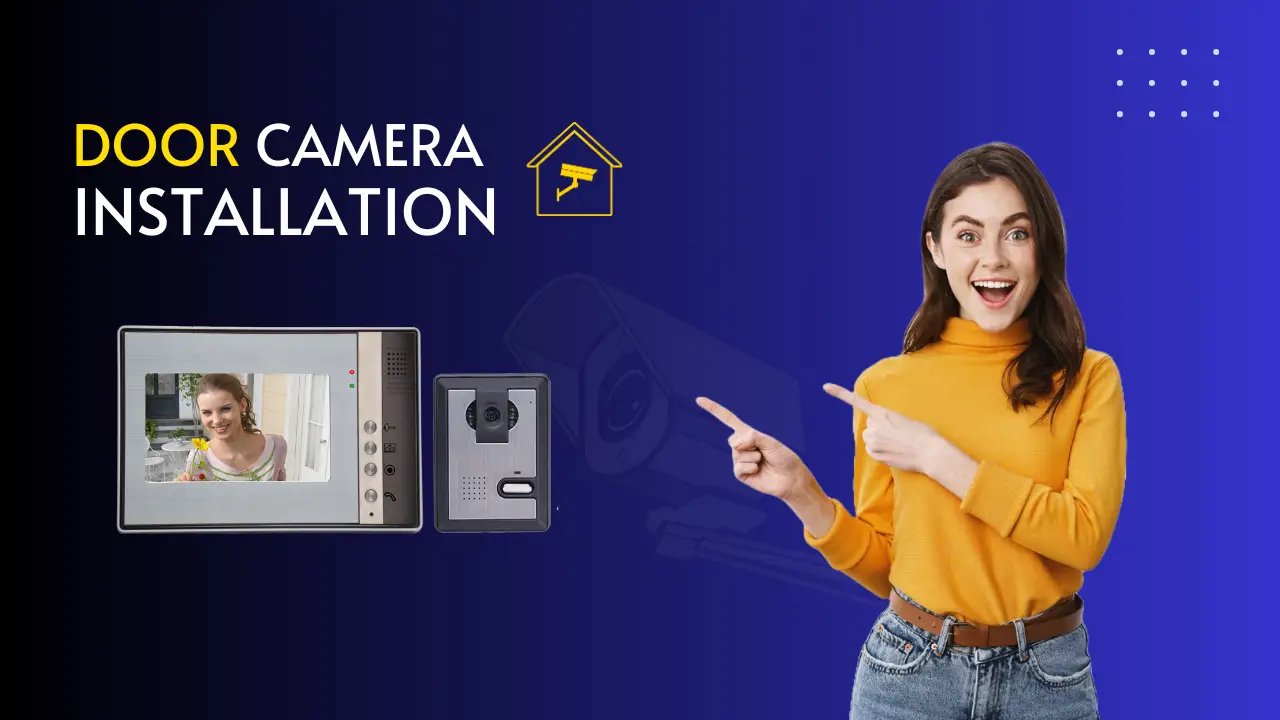Burglars break into UK homes every 30 seconds. A simple door camera can substantially reduce this risk. Technology has transformed door cameras from simple monitoring devices into smart security solutions with up-to-the-minute alerts, two-way communication, and HD video recording.
The right installation plays a vital role in getting optimal performance from your wireless video doorbell or hardwired security camera. This piece walks you through the essentials of door camera installation. You will learn about choosing the perfect location and setting up your wireless connexion to enhance your home’s security.
7 best video doorbells for upgrading your home security system
Our extensive testing of door cameras has led us to select the best options for home security. These video doorbells have distinct features that suit various needs and budgets.
Ring Video Doorbell 2nd Generation excels with 1080p HD video resolution and a wide 160-degree field of view. Its infrared night vision works well, and the person detection feature cuts down false alerts. The device combines smoothly with Alexa, which makes it ideal for smart home integration.
Blink Video Doorbell stands out for its affordable price and simple design. You can install this wireless device in minutes, and the battery lasts up to two years when configured properly. The doorbell delivers 1080p resolution and works with Alexa, while offering local storage through the Sync Module 2.
EZVIZ DB2 brings great value with 2K resolution and an ultra-wide 176-degree viewing angle. The 5,200 mAh rechargeable battery runs for up to 115 days. A built-in voice changer adds privacy protection.
Toucan Wireless Video Doorbell comes with a 180-degree field of vision that monitors visitors and packages effectively. The built-in rechargeable battery runs for 4-6 months based on use. You can place its chime unit anywhere in your home.
Eufy S200 uses dual cameras for complete coverage. Clear head-to-toe viewing and advanced AI detection reduce false alerts. The customizable motion detection zones enhance its functionality.
Aqara G4 supports local facial recognition and multiple ecosystems including HomeKit Secure Video. The voice-changing function enhances privacy with four voice options. Its indoor chime serves as a repeater that creates stable connexions.
Tapo D230S1 delivers 2K video quality and performs well in low light. The 6,700mAh battery lasts up to six months, and the AI features work without a subscription. These features include person, animal, and package detection.
| Feature | Resolution | Battery Life | Field of View |
|---|---|---|---|
| Ring 2nd Gen | 1080p | Varies | 160° |
| Blink | 1080p | Up to 2 years | 135° |
| EZVIZ DB2 | 2K | 115 days | 176° |
| Toucan | 1080p | 4-6 months | 180° |
| Eufy S200 | 2K | 3-6 months | 160° |
| Aqara G4 | 1080p | 4 months | 162° |
| Tapo D230S1 | 2K | 6 months | 160° |
Door Installation Process
Your door camera needs proper installation to work well and keep your home secure. This piece walks you through everything you need to know to set up your device the right way.
Height and Angle Guidelines
The best spot to mount your door camera is 48 to 58 inches above the ground. This height range gives you the clearest view of visitors’ faces and helps detect motion better. The camera works best when it can catch movement across its view rather than straight on.
What you need to watch out for:
- Stay away from direct sunlight that creates glare
- Make sure you can see the doorway and nearby areas clearly
- Keep the camera clear of anything hanging above it
- Let it catch motion from side to side
Drilling and Anchoring Tips
The right drill bits make all the difference based on where you’re mounting:
- 3mm bit works for wood without wall plugs
- 6mm bit is perfect for masonry or brick work
Mark your spots carefully and grab a level to line everything up right. Brick installations work better when you drill into the mortar instead of the brick – it’s easier to work with and holds better too.
Weather Protection Measures
Your door camera needs good protection from weather to last longer. Here are some proven ways to shield your device:
| Protection Type | Benefits | Best For |
|---|---|---|
| Rain Cover | Prevents water damage | All climates |
| Sun Shield | Reduces glare | Sunny locations |
| Weather Hood | Complete protection | Exposed areas |
Good moisture sealing helps protect your investment. Exposed locations need both weatherproof covers and a slight downward angle to keep water from collecting.
The wiring needs special attention during installation. Hardwired setups need proper insulation and moisture protection. Battery-powered units work better when you check their weather seals often.
Test your camera’s motion sensing and video quality after you mount it. Small position tweaks can make a big difference in how well your camera performs. You might need to adjust the angle to get the perfect mix of coverage and performance.
Essential Tools and Materials
The right tools and materials make door camera installation successful. Our installation experience has helped us create a detailed list of everything you need.
Required Installation Tools
Your video doorbell setup needs both simple and specialised tools. Here are the vital items to ensure proper installation:
| Basic Tools | Specialised Tools |
|---|---|
| Power drill/driver | Masonry drill bits |
| Screwdriver set | Wire strippers |
| Measuring tape | Level |
| Pencil | Box cutter |
Wiring and Mounting Hardware
These mounting components should be ready before you start the installation:
- Standard mounting plate (typically included)
- Anchors and screws for different surfaces
- No-drill adhesive mounts for rental properties
- Weather-resistant mounting blocks
- Corner mounting kits for specialised angles
Hardwired installations need proper electrical connexions with diodes for digital chimes and extension wires as needed. Surface materials can vary unexpectedly, so keep spare mounting hardware handy.
Safety Equipment Needed
Proper safety measures matter with electrical components and power tools. We use these items consistently:
Essential Safety Gear:
- Protective eyewear for drilling
- Work gloves for handling sharp edges
- Dust mask when drilling masonry
- Voltage tester for electrical work
- Circuit breaker locator
A multimeter set to AC volts helps test connexions on existing doorbell wiring. Battery-powered units don’t need electrical safety gear, but proper safety protocols during mounting still apply.
Store specialised security screwdrivers that come with your door camera safely – you’ll need them for future maintenance and battery changes. Tool organisation before starting makes the installation process smoother and safer.
Power Supply Requirements
Your door camera’s performance depends significantly on its power requirements. A proper power supply assessment can prevent most common installation issues.
Existing Doorbell Wiring Assessment
The first step is to check your existing doorbell system’s components. A transformer that converts standard 110-120V power to lower voltage needed for door cameras is the key element. Most homes have transformers in these locations:
- Basement or attic near electrical panels
- Utility rooms close to HVAC systems
- Storage closets under stairs
- Near security system control panels
Battery vs Hardwired Options
Our extensive testing of both power options reveals this comparison:
| Feature | Hardwired | Battery-Powered |
|---|---|---|
| Power Supply | Continuous | 4-6 months per charge |
| Installation | Complex wiring | Simple mounting |
| Reliability | Works during outages | Needs monitoring |
| Features | Advanced recording | Simple functions |
| Maintenance | Minimal | Regular charging |
Voltage and Compatibility Check
Our testing confirms that most modern video doorbells need specific voltage parameters:
Standard Requirements:
- Operating voltage: 16-24 VAC
- Frequency: 50/60 Hz
- Power rating: 10-40 VA (Volt-Ampere)
A multimeter check of your system’s voltage before installation is essential. Important safety warning: Never connect your door camera directly to mains voltage, as this will damage the device and create safety hazards.
Battery-powered units offer more flexibility in placement but need regular maintenance. These models use their battery as the primary power source when hardwired, while the wiring provides a continuous trickle charge.
Wiring Configuration
Your door camera needs proper wiring to work reliably and safely. Our team has installed hundreds of these devices and knows exactly what makes them work perfectly.
Connecting to Existing Doorbell
Safety comes first – we always cut power at the breaker box. The connexion to your existing doorbell needs a jumper cable to bypass the traditional chime. Here’s our proven process:
- Remove the doorbell chime cover
- Locate ‘Front’ and ‘Trans’ terminals
- Connect jumper cable while keeping existing wires in place
- Secure all connexions with terminal screws
- Replace the cover carefully
Installing a Power Transformer
The transformer’s installation demands exact specification matching. Your transformer should meet these requirements:
| Specification | Required Range |
|---|---|
| Voltage | 10-24 VAC |
| Frequency | 50/60 Hz |
| Power Rating | 10-40 VA |
The transformer needs to be secured in an available location, usually near the doorbell chime or in an electrical box. Important: Transformers should never go in enclosed spaces without proper ventilation.
Testing Electrical Connexions
Our detailed testing protocol makes sure everything works perfectly:
To test transformer:
- Check input voltage (should be 120V AC)
- Verify output voltage (16-24V AC ideal)
- Test under load conditions
A multimeter helps us check connexions at both transformer and doorbell ends. Voltage readings below 16V at the door camera might indicate voltage drop problems from wire length or quality.
Critical Safety Note: Power must be off before making any connexions, and we verify this with our voltage tester. Existing wiring needs secure wire nuts and tight connexions.
Hardwired installations need excess wiring tucked properly into the wall cavity. Loose wires can create interference or connexion problems over time. The system powers up gradually after connexion, and we watch the LED indicator to confirm everything works right.
Network Setup and Configuration
Your door camera needs a reliable network connexion to work well. Let me show you how to set it up and get the best performance possible.
WiFi Signal Requirements
Our tests show that door cameras work with specific WiFi frequencies. The 2.4GHz networks give better coverage for door cameras, especially when you have a larger home. Here’s what we learned about WiFi requirements:
| Feature | 2.4GHz Network | 5GHz Network |
|---|---|---|
| Range | Excellent | Limited |
| Wall Penetration | Superior | Moderate |
| Interference | More common | Less common |
| Speed | Adequate | Faster |
Your router should be within 30 feet of your door camera to get the best performance. Thick walls, metal objects, and large mirrors can affect your signal strength by a lot.
App Installation and Setup
Start by downloading the manufacturer’s app from your device’s app store. Here are the vital steps that will help you configure everything correctly:
- Create your account and verify email
- Enable location services for initial setup
- Press the setup button on your door camera
- Connect to the camera’s temporary network
- Input your home WiFi credentials
Important: Make sure your mobile device meets the minimum system requirements before you begin. Most apps need iOS 10.0 or Android 5.0 or newer versions.
Testing Connectivity
Here’s how you can check if your door camera connects properly:
- Look at the signal strength in the app’s device health section
- Check video streaming quality at different times
- See how fast motion alerts come through
- Test if two-way audio works
Start with the simple things if you have connexion problems. Your internet speed should be at least 2 Mbps for both upload and download. A WiFi extender or moving your router might help if your signal shows as “poor” or “very poor.”
Test your connexion regularly to keep everything running smoothly. This becomes more important after router firmware updates or changes to your home network setup. A strong WiFi signal helps you get smooth video streaming and quick motion detection alerts.
How to choose the best video doorbell
Buying the right video doorbell means looking at several important features. Our extensive tests have helped us identify what makes these devices work well and keep users happy.
Video Quality and Field of View The quality of your video resolution affects how well you can see visitors and spot suspicious activity. Our tests show that 1080p is the bare minimum to get clear footage, while 2K resolution gives you better details to monitor packages and recognise faces. You’ll want a field of view between 150-180 degrees to see your entire entryway.
| Feature Priority | Essential Specs | Why It Matters |
|---|---|---|
| Video Quality | 1080p minimum | Clear visitor identification |
| Field of View | 150-180 degrees | Complete doorway coverage |
| Night Vision | IR or LED | 24/7 monitoring capability |
| Audio Quality | Full-duplex | Natural conversation flow |
Smart Features and Integration The best door cameras we tested come with:
- AI-powered person detection
- Package recognition capabilities
- Smart home platform compatibility
- Custom motion zones
- Rich notifications with preview images
Storage and Privacy Considerations Our tests show that storage options affect your long-term costs and how well the system works. Cloud storage usually needs a subscription, while local storage is a one-time purchase. You should look at both the purchase price and any ongoing fees before making your choice.
These privacy features matter most:
- End-to-end encryption
- Two-factor authentication
- Customizable privacy zones
- Local processing options
- Secure data storage practises
Power and Connectivity Requirements The power source you pick greatly changes how well your system performs and how much maintenance it needs. Hardwired systems give you steady power but need existing doorbell wiring. Battery-powered units let you place them anywhere but need regular charging.
Your WiFi connexion should have at least 2 Mbps upload speed to stream video well. We found that 2.4GHz networks reach farther and go through walls better than 5GHz options.
Weather Resistance and Durability Our tests in different weather conditions prove that protection ratings matter. Look for IP65 or higher ratings to guard against rain, snow, and dust. Your local weather should guide your choice – places with extreme temperatures need extra protection.
Your specific situation should guide your final choice. Renters might do better with a battery-powered option, while homeowners could benefit from investing in a hardwired system with advanced features. The best door camera balances your security needs with practical setup and maintenance requirements.
Battery vs wired
The choice between battery-powered and wired door cameras affects everything from setup to maintenance. Our extensive tests show that both options work great in different situations.
Battery-powered doorbells are super easy to install. You can put them anywhere within WiFi range, which makes them perfect for homes without doorbell wiring or rental properties where you can’t make permanent changes. Our tests show that today’s battery-powered units usually last 4-6 months on one charge, but this changes based on how much you use them and the weather.
| Feature | Battery-Powered | Wired |
|---|---|---|
| Installation | DIY-friendly | Professional recommended |
| Power Source | Rechargeable battery | Home electrical system |
| Maintenance | Regular charging needed | Minimal upkeep |
| Placement | Flexible | Near existing wiring |
| Performance | Weather-dependent | Consistent |
Wired systems really shine when it comes to reliability and steady performance. These units get power straight from your home’s electrical system through a transformer and work non-stop without battery worries. Wired doorbells usually run at 16-24 volts, which gives them enough juice for fancy features like continuous recording.
Our hands-on experience with battery-powered units taught us some key things:
- Battery life changes a lot based on motion detection
- Batteries don’t work as well in cold weather
- Some models charge slowly when hardwired
- You need to watch battery levels regularly
- Easy placement beats the extra maintenance work
Wired systems handle extreme weather better. The biggest challenge is installation. You might need a professional installation, especially if your home doesn’t have doorbell wiring or needs a new transformer.
Some battery-powered models take a hybrid approach. These units use their battery as the main power source while getting a steady trickle charge from wiring. This setup gives you battery flexibility and wired reliability, but lots of motion alerts or bad weather can drain the battery faster than it can recharge.
Weather plays a big role in how these systems work. Battery units need more attention in extreme temperatures. Heat shortens battery life, and cold weather means more frequent charging. Wired systems keep working the same way no matter the temperature, but both types need good weatherproofing to last long.
Renters and apartment dwellers should go for battery-powered options. They’re easy to install and remove. Homeowners who want a permanent solution might prefer wired systems because they’re more reliable and need less maintenance.
Conclusion
Door cameras are a great way to get security benefits and make valuable additions to any home. We looked at many aspects of these devices, from high-quality options like the Ring Video Doorbell 2nd Generation to significant installation factors and power needs.
Your door camera’s successful installation needs careful planning, proper tool selection, and a clear understanding of your home’s requirements. Each option has unique advantages you should think over, whether you pick a battery-powered unit for flexibility or a wired system for reliability.
Your door camera’s performance depends on smooth connectivity and correct positioning. The best approach is to check your WiFi signal strength and pick the perfect mounting spot before installation. Regular maintenance keeps your door camera working reliably. This includes checking batteries in wireless units and testing connexions in wired systems.
Smart home security begins with the right choices. Your door camera will protect your home and give you peace of mind with proper installation and consistent maintenance.




